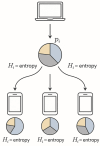FedEmerge: An Entropy-Guided Federated Learning Method for Sensor Networks and Edge Intelligence
- PMID: 40573615
- PMCID: PMC12197170
- DOI: 10.3390/s25123728
FedEmerge: An Entropy-Guided Federated Learning Method for Sensor Networks and Edge Intelligence
Abstract
Introduction: Federated Learning (FL) is a distributed machine learning paradigm where a global model is collaboratively trained across multiple decentralized clients without exchanging raw data. This is especially important in sensor networks and edge intelligence, where data privacy, bandwidth constraints, and data locality are paramount. Traditional FL methods like FedAvg struggle with highly heterogeneous (non-IID) client data, which is common in these settings. Background: Traditional FL aggregation methods, such as FedAvg, weigh client updates primarily by dataset size, potentially overlooking the informativeness or diversity of each client's contribution. These limitations are especially pronounced in sensor networks and IoT environments, where clients may hold sparse, unbalanced, or single-modality data. Methods: We propose FedEmerge, an entropy-guided aggregation approach that adjusts each client's impact on the global model based on the information entropy of its local data distribution. This formulation introduces a principled way to quantify and reward data diversity, enabling an emergent collective learning dynamic in which globally informative updates drive convergence. Unlike existing methods that weigh updates by sample count or heuristics, FedEmerge prioritizes clients with more representative, high-entropy data. The FedEmerge algorithm is presented with full mathematical detail, and we prove its convergence under the Polyak-Łojasiewicz (PL) condition. Results: Theoretical analysis shows that FedEmerge achieves linear convergence to the optimal model under standard assumptions (smoothness and PL condition), similar to centralized gradient descent. Empirically, FedEmerge improves global model accuracy and convergence speed on highly skewed non-IID benchmarks, and it reduces performance disparities among clients compared to FedAvg. Evaluations on CIFAR-10 (non-IID), Federated EMNIST, and Shakespeare datasets confirm its effectiveness in practical edge-learning settings. Conclusions: This entropy-guided federated strategy demonstrates that weighting client updates by data diversity enhances learning outcomes in heterogeneous networks. The approach preserves privacy like standard FL and adds minimal computation overhead, making it a practical solution for real-world federated systems.
Keywords: Polyak–Łojasiewicz condition; convergence analysis; emergent collective learning; entropy; federated learning; model aggregation; non-IID data.
Conflict of interest statement
The authors declare no conflicts of interest. The funders had no role in the design of the study; in the collection, analyses or interpretation of data; in the writing of the manuscript; or in the decision to publish the results.
Figures






References
-
- Yang Q., Liu Y., Chen T., Tong Y. Federated Machine Learning: Concept and Applications. ACM Trans. Intell. Syst. Technol. 2019;10:12:1–12:19. doi: 10.1145/3298981. - DOI
-
- Liu X., Chen A., Zheng K., Chi K., Yang B., Taleb T. Distributed Computation Offloading for Energy Provision Minimization in WP-MEC Networks with Multiple HAPs. IEEE Trans. Mob. Comput. 2025;24:2673–2689. doi: 10.1109/TMC.2024.3502004. - DOI
-
- Akyildiz I.F., Su W., Sankarasubramaniam Y., Cayirci E. A Survey on Sensor Networks. IEEE Commun. Mag. 2002;40:102–114. doi: 10.1109/MCOM.2002.1024422. - DOI
-
- Giorgetti A., Tavella P., Fantacci R., Luise M. Wireless Sensor Networks for Industrial Applications. IEEE Trans. Ind. Inform. 2020;16:6343–6352.
-
- Li X., Gu Y., Diao Y., Chen Y., He Y. Federated Learning in the Internet of Things: Concept, Challenges, and Applications. IEEE Internet Things J. 2020;7:4890–4900.
LinkOut - more resources
Full Text Sources

